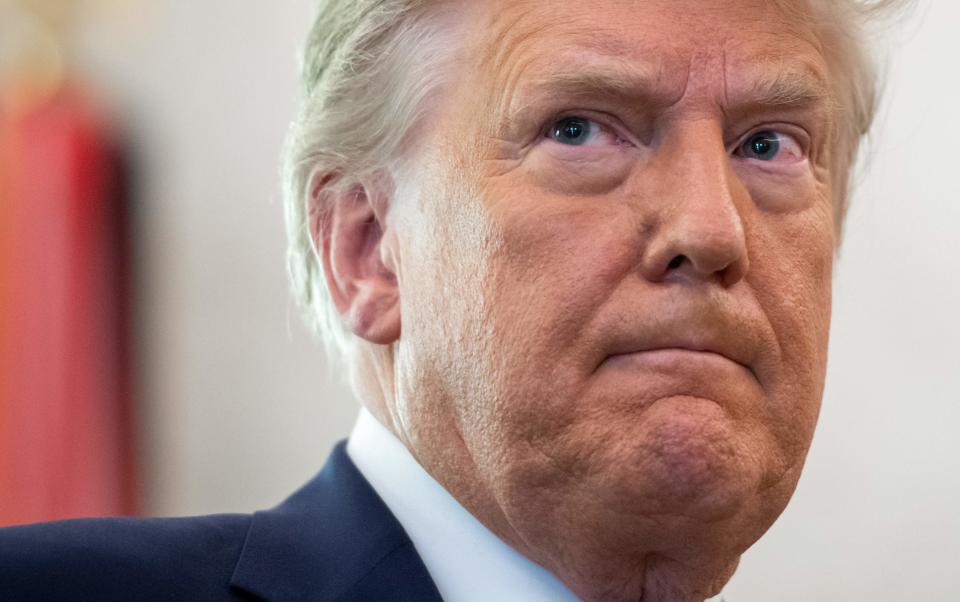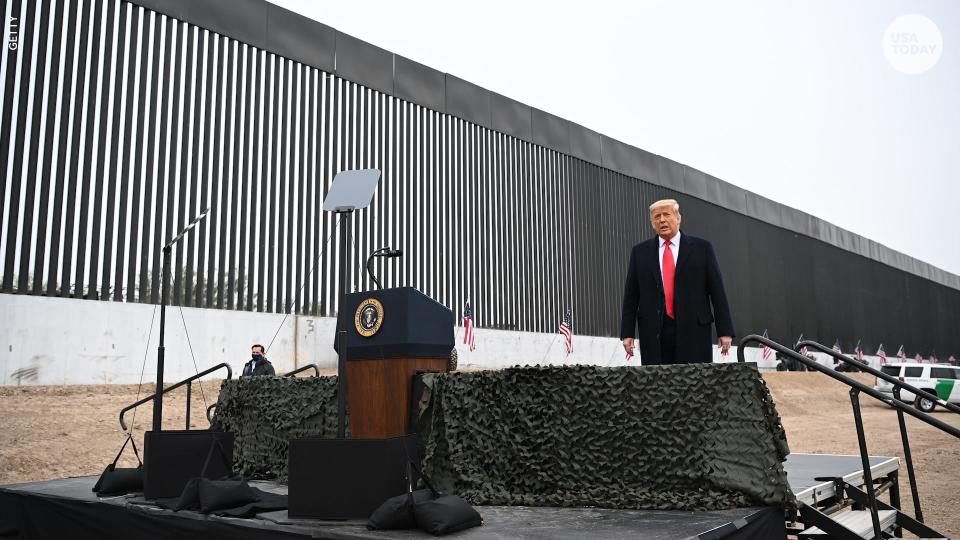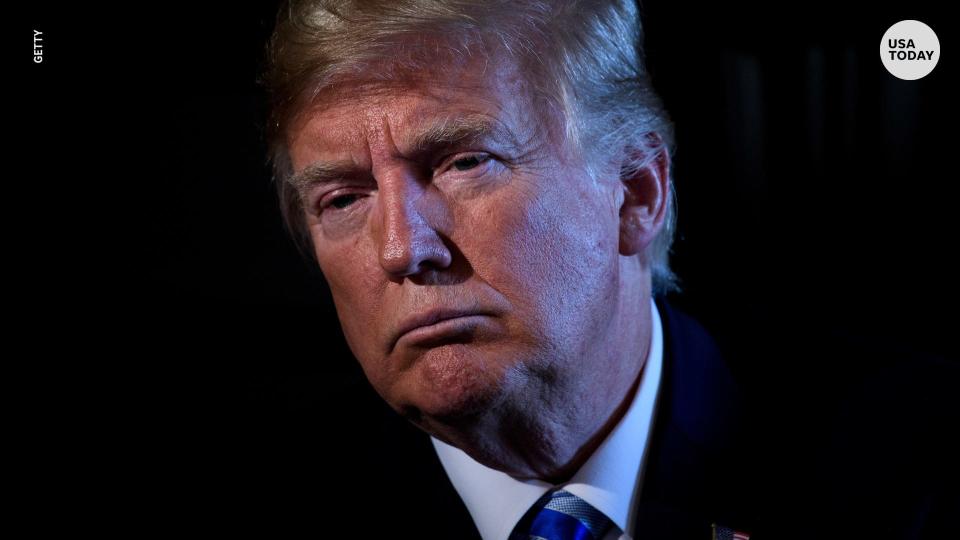From the border to the federal bench to raging political divisions: How Donald Trump's tenure has changed America
WASHINGTON – President Donald Trump's time in the White House will come to an end Wednesday, but his influence – for better or worse – will continue to shape politics in Washington and the rest of the nation far beyond his four years in office.
From early legislative victories, such as the massive overhaul of federal taxes in 2017, to the depths of a second, historic impeachment this month after riots at the U.S. Capitol, Trump's tenure has been marked by a norm-busting approach to the job that has delighted supporters and alarmed critics on a nearly 24-hour-a-day basis.
Trump will leave the White House before the inauguration of President-elect Joe Biden – weakened by the fallout of a raging coronavirus pandemic, pummeled by bipartisan criticism in response to months of false assertions of election fraud and stunned by the loss of two critical runoffs in once-red Georgia that handed Democrats control of the Senate.
The Capitol insurrection will shadow the president long after he leaves Washington amid anger from Democrats and many Republicans over his role in encouraging supporters to try to overturn election results that were certified in all 50 states and the District of Columbia.
The catastrophic events of 2020 and early 2021 left political observers bearish on whispers that Trump is considering another run for president in 2024.
"Trump over the next few years is far more likely to become reviled than lionized," predicted Lara Brown, director of the Graduate School of Political Management at George Washington University. "Having no official power, his appeal will continue to wane among the more traditional conservatives who long kept quiet about his controversial leadership."
No matter what Trump does, the tumultuous four years he has just put behind him have already left a mark. He can – and will – claim credit for major shifts in U.S. immigration policy, steering the federal bench to the right and even changing the way politicians communicate. As ever, those changes will inspire heated debate.
Here's a look at five areas where Trump's presidency changed the nation:

Harsher tone for politics
From his early false claims that Mexico was sending "rapists" to the USA to his final rally near the White House that prompted some followers to storm the U.S. Capitol on Jan. 6, Trump upended political speech in ways that may be hard to reverse.
Supporters reveled in how Trump's rhetoric flouted convention, tapping into the angst millions of Americans feel about the country's direction. Opponents have been horrified that Trump's words often seemed designed to divide and denigrate rather than to bring together a nation frayed by division.
After a few years into Trump's term, personal name calling in politics had become so routine that it hardly registered when Biden referred to the president as a "clown" during their first debate in September or House Speaker Nancy Pelosi called him a "coward" in an interview in 2019. The discourse devolved further when a reporter overheard Rep. Ted Yoho, R-Fla., describe Rep. Alexandria Ocasio-Cortez, D-N.Y., as "disgusting" – and far worse – in an exchange reported last year by The Hill newspaper.
Trump didn't create the nation's divisions over truth and fact, but he exacerbated them with baseless claims of stolen elections and deep state conspiracies. For millions, he fueled a long-simmering distrust of government – and that, experts said, could have unseen and corrosive ramifications for years, if not decades, to come.
"Trump took advantage of preexisting distrust, polarization and frustration in America and used rhetorical strategies that were designed to make all of those negative things worse," said Jennifer Mercieca, a historian of American political rhetoric and an associate professor at Texas A&M University.
The president remained uncharacteristically out of sight during his final weeks in the West Wing, an absence amplified by Twitter's decision on Jan. 8 to lock his account.
If past is prologue, Trump won't remain out of sight for long.
"No person in American history has had as much rhetorical power as Donald Trump has had over the past five years," Mercieca said. "Now that he's been de-platformed, he has less rhetorical power than any president since William Howard Taft."
Changed federal judiciary
Though it has taken place with little Trumpian fanfare or controversy, the president's success in appointing conservatives to the federal bench may be among his most lasting achievements – a tide that could have implications for health care, gun control, abortion, LGBTQ rights and other pressing issues for a generation of Americans.
The most prominent of those were made to the Supreme Court, where Trump seated three justices – Neil Gorsuch, Brett Kavanaugh and Amy Coney Barrett – over the course of four years in the White House. The 6-3 conservative-liberal split has put the court on its most conservative footing since the 1930s, when it became a bulwark against President Franklin D. Roosevelt's more ambitious New Deal programs.

The judicial appointment spree has been just as pronounced in lower courts, which will help determine which cases rise to the Supreme Court. Trump appointed 226 federal judges, including 54 appellate judges – or about a third of the 179 appellate judgeships – according to a Pew Research Center report. That has flipped the ideological leanings of three of the nation's 13 circuit courts.
"These judges have already shown an unflagging commitment to the rule of law, even in the face of intense political pressure," said Carrie Severino with the conservative Judicial Crisis Network. "I have no doubt that they will continue to make the Constitution their utmost priority for many decades to come."
Immigration, border changes

Trump never came close to finishing the "big, beautiful wall" he promised would run along 1,000 miles of the U.S.-Mexican border, but he ushered in major changes in immigration policy – many of which will be tricky for Biden to unwind.
Unable to broker agreement with Congress on a broad immigration plan, Trump acted unilaterally to slash the nation's asylum program and deny entry to Central American migrants, many of whom wait in Mexico instead of the USA as their claims are processed. He applied diplomatic pressure on Mexico and Central America to stem the flow of people seeking to flee violence and poverty. And he redirected billions in military funding to rebuild portions of the barrier on the nation's southern border.
Immigration: Biden might need years to reverse Trump's immigration policies
Trump enacted more than 400 policies in an attempt to shrink legal and illegal immigration, according to the nonpartisan Migration Policy Institute.
Many of those changes were controversial, forcing Americans to reexamine their history as a nation created by immigrants. The debate played out most prominently under the Trump administration's 2018 "zero tolerance" policy, which required criminal prosecution of undocumented border crossers and led to a vast expansion of family separations. Facing blowback and legal challenges, Trump reversed the policy weeks later.
"President Trump's biggest legacy on immigration will be significantly expanding the executive's authority over and involvement in immigration policymaking," said Sarah Pierce, policy analyst at the Migration Policy Institute.
"There has never been such an activist administration on immigration," she said, noting the White House revealed all the ways a president can influence immigration. "In doing so, they have paved the way for future administrations to become similarly involved in immigration and made the system even move vulnerable to sharp swings in policy."
Reshuffling of alliances
Trump summed up his foreign policy in two words – America first – but there is sharp disagreement over whether his handling of world affairs will boost the country's interests or reduce its standing. The president challenged assumptions about the world order that emerged after World War II, often squeezing long-standing allies, praising dictators and rewriting decades of trade policy. He blasted European countries for not contributing more to NATO and widely dismissed the multilateral engagements pursued for decades by both parties.
After attempts to contain North Korea's nuclear ambitions largely failed, Trump met with that country's ruler, Kim Jong Un, three times – an approach that didn't fare much better. He tossed out a controversial nuclear deal with Iran. Toward the end of his term, he trumpeted the establishment of diplomatic relations between the United Arab Emirates, Bahrain and other countries with Israel.
Trump won bipartisan support for his efforts to pressure China to reform its trade policies, and he secured a new agreement with Mexico and Canada to replace the often maligned, 26-year-old NAFTA deal. Critics said those struggles may have yielded more if Trump had worked with allies in Europe instead of launching separate trade battles and rhetorical broadsides against them.
"It will be difficult – if not impossible – to repair this damage anytime soon," Richard Haass, president of the Council on Foreign Relations and an adviser to Presidents George H.W. Bush and George W. Bush, wrote last week. "While the world was already in growing disarray, and while U.S. influence was already declining, Trump dramatically accelerated both trends."

Regulations vs. climate
From coal emissions to airline bag fees, Trump went on an anti-regulation sprint that experts said may have accelerated economic growth but could have lasting effects on the environment as well as federal consumer and worker protections.
Trump presided over a growing economy, then a recession after the coronavirus shuttered businesses and hammered industries such as travel and tourism. Unemployment continued a fall that began during President Barack Obama’s tenure, dropping to 3.5% this year before the pandemic sent the jobless number soaring. Stock prices climbed, and the Dow Jones Industrial Average recovered from the coronavirus sell-off last year.
More: Trump orders two-for-one repeal for all new regulations
The White House points to several factors to explain pre-pandemic economic growth, including its more hands-off approach to federal regulations. Though Trump came short of massive deregulation, his administration hit the brakes on new rules. That slowdown may have contributed to optimism in some industries, experts said.
It may leave the Biden administration with a lengthy to-do list.
Trump agencies published 107 new economically significant regulations from 2017 through 2019, defined as having expected yearly impacts of at least $100 million. That compares with 175 such rules during the first three years of Obama’s term, according to data compiled by the Regulatory Studies Center at George Washington University.
“While actual deregulation during the Trump administration didn’t match the rhetoric, his agencies did reduce the pace of new regulations dramatically,” said the center’s director, Susan Dudley.
Removing regulations prompted cheers from some and drew howls from environmentalists and other groups. Trump’s Environmental Protection Agency moved in 2017 to drop a rule reducing emissions from coal-burning power plants. A rule requiring companies to report wage data by gender and ethnicity was suspended.
Lost bags, airline fees: Protections for travelers rights stall under Trump
Even airline bag fees became a target: The Department of Transportation withdrew an Obama-era rule that would have required airlines to disclose bag fees alongside their ticket price so consumers could factor in the added costs when buying a flight.

Obamacare stands
One area where the president had less impact than expected: the Affordable Care Act, also known as "Obamacare."
During his 2016 campaign, Trump repeatedly promised to repeal Obama's signature domestic policy achievement. Among other provisions, the 2010 law set up health care marketplaces that allow people without coverage to buy a health policy.
In a blow to Trump, the push to repeal the law failed in 2017 after a dramatic session in which Sen. John McCain, R-Ariz., cast a deciding vote against it. Trump never forgave McCain and continued to bring up his vote at rallies years after the senator died in 2018.
Trump managed to chip away at the law, including by eliminating an unpopular provision requiring Americans to have some form of health insurance or face a tax penalty. But he never was able to replace it. Despite promising for years to unveil a better vision, the closest he came was an executive order last year that demanded protection for people with preexisting conditions – something already codified in the Obamacare law.
"And now we have it affirmed," Trump asserted as he signed the order. "This is affirmed, signed and done, so we can put that to rest."
Despite efforts to undermine the Affordable Care Act, enrollment has remained relatively steady throughout Trump's term. About 12 million people enrolled in an ACA plan in 2017, the first year Trump took office, according to the nonpartisan Kaiser Family Foundation. By the end of 2020 – after years of Trump's harsh criticism of the law – enrollment had fallen to 11 million people.
Contributing: Bart Jansen
This article originally appeared on USA TODAY: Here's how Trump's tumultuous four years as president changed America.

 Yahoo Movies
Yahoo Movies 